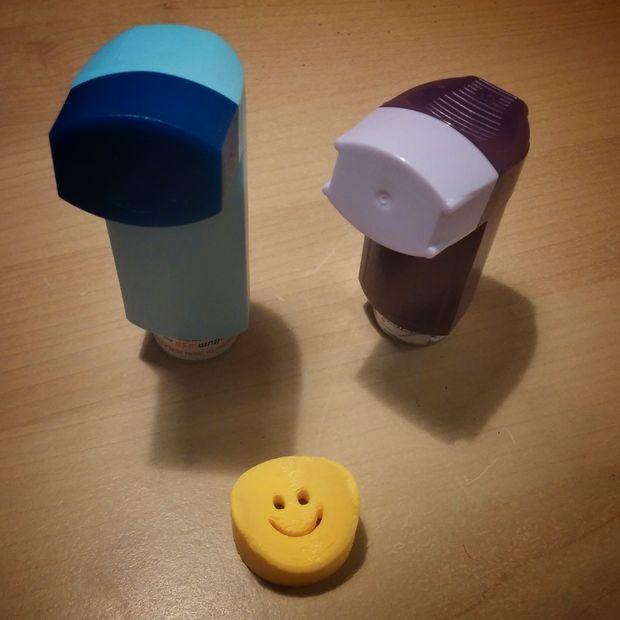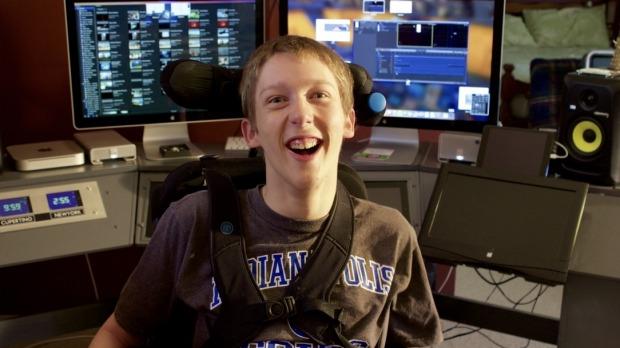Christopher Hills has cerebral palsy and quadriplegia. The nineteen-year-old Australian man, who has control only over his neck muscles, would have, until only recently, been resigned to a life of dependency on others. Instead, he’s the owner of a successful video editing business. Hills runs Switched-On Video Editing, and in his home office on the Sunshine Coast, he produces, directs and edits videos using sophisticated and complex film software that many people struggle to perfect. Hills, however, is a master of the technology, which he operates using only the muscles in his neck, thanks to a switch on his wheelchair.
The switch, mounted next to his head, allows Hills to control everything the way a mouse would. All he has to do is move his head to create finely wrought films that would be beyond the capabilities of most people with fully functioning limbs, and his talent has earned him accolades from several high-profile clients. Recently he produced, directed and edited a film for the National Disability Insurance Scheme, and he himself is only one example of how technology is breaking through the limitations of even the most severe disabilities.If you follow 3D printing news at all, you’re likely well acquainted with the incredible ways the technology can change the lives of people with disabilities. We cover 3D printed prosthetic devices frequently, and while they never fail to amaze, they barely scratch the surface of the possibilities in 3D printed assistive technology. Much of that technology benefits people like Hills who have very little motor function, and some of the most ingenious designs come from members of the public thanks to crowdsourcing initiatives like MakerBot’s Assistive Technology Challenge.
We hear a lot about how 3D printing is putting manufacturing and invention into the hands of the people, and that’s perhaps most poignantly evident through the life-changing devices that ordinary makers come up with. There’s no risk of large biomedical corporations being put out of business anytime soon; the average hobbyist isn’t going to start churning out titanium implants or organ tissue in his or her living room. But while those are the stories that make headlines, it’s often the simplest inventions that can make the biggest difference in individual lives.
 Take this ergonomic asthma inhaler, for example. This simple 3D printed smiley face, presented as a mere two-step Instructable, is not only cute and kid-friendly, but could potentially save a life. As the creator, giulio75, an asthma sufferer himself, explains, the correct use of an inhaler is vital but often difficult. Holding the canister in a stable position while pressing the button can be a challenge, especially when in the midst of an attack, and the little smiley face cap, easily fitted onto the top of the canister, both stabilizes it and makes it easier to press. Simple, yet potentially lifesaving, eliminating a difficulty that someone having a severe attack just doesn’t have time for.
Take this ergonomic asthma inhaler, for example. This simple 3D printed smiley face, presented as a mere two-step Instructable, is not only cute and kid-friendly, but could potentially save a life. As the creator, giulio75, an asthma sufferer himself, explains, the correct use of an inhaler is vital but often difficult. Holding the canister in a stable position while pressing the button can be a challenge, especially when in the midst of an attack, and the little smiley face cap, easily fitted onto the top of the canister, both stabilizes it and makes it easier to press. Simple, yet potentially lifesaving, eliminating a difficulty that someone having a severe attack just doesn’t have time for.
As in the above example, it’s often the disabled who best understand the needs of their fellow afflicted, and 3D printing gives them a way to address those needs through their own innovations. At Greenacres Disability Services in Wollongong, disabled workers actually build 3D printers for the education-centered Australian printer company Me3D. Not only does the work provide meaningful employment, but it has given the workers a way to design and print devices that make their own day-to-day lives easier. While testing the printers they had constructed, several of the Greenacres workers decided to print customized handles to slip over tools and make them easier to grip.
“Customising individual grip covers for tools means they are not trying to do something that doesn’t work for them,” said John Harvey, general manager at Greenacres. “Working with a screwdriver or Allen key is now easier. We have 250 workers, and it means that they’re not struggling, and it builds confidence. It means they can do other jobs they couldn’t do before.”
 The workers also printed similar covers for wheelchair control joysticks, meaning that multiple individuals can easily use the same wheelchair simply by changing the grip covers. Wheelchair controls are an excellent, and increasingly common, example of how 3D printing can easily and cheaply circumvent challenges.
The workers also printed similar covers for wheelchair control joysticks, meaning that multiple individuals can easily use the same wheelchair simply by changing the grip covers. Wheelchair controls are an excellent, and increasingly common, example of how 3D printing can easily and cheaply circumvent challenges.
Melissa Fuller founded AbilityMate, an open source community that links people in need with designers and makers who create customizable assistive devices. Wheelchair joysticks are some of the most common requests, she said, as even the most expensive wheelchairs often come with joysticks that are difficult to operate due to the nature of certain disabilities. She gave an example of a woman with cerebral palsy whose $35,000 wheelchair came with a joystick she couldn’t operate.
“She finds it hard to keep her hands still,” Fuller said. “It’s hard for her to drive the wheelchair because it’s not suited to her hand movements. The middle finger is the only movement she has. In about two hours with rapid prototyping, we 3D printed a joystick for her. The materials cost 37¢. The waiting list for a modification of the original device was six months at a cost of $1000.”
Another control was designed to look like an Atari joystick, for a young man who played a lot of Atari before suffering from a traumatic brain injury. Not only is the controller appealing to him, Fuller said, but it helps him remember the fine motor skills he used before his injury.
AbilityMate and Me3D are both part of Autodesk’s Entrepreneur Impact Program, which gives free access to 3D design software like Fusion 360, 123Design and Tinkercad to small businesses dedicated to environmental or social issues. If you’re a startup in the business of helping the afflicted or otherwise improving lives, you can apply to be a part of the program here.
The abovementioned are only a few examples of how 3D printing can make a big impact in a small way, but there are always more people in need. The great news is that it’s easier to fulfill those needs than ever before, and the average person can make a huge impact with just a bit of 3D design skill. Discuss further in the 3D Printed Assistive Devices forum over at 3DPB.com.
[Main source: Brisbane Times]Subscribe to Our Email Newsletter
Stay up-to-date on all the latest news from the 3D printing industry and receive information and offers from third party vendors.
You May Also Like
Gorilla Sports GE’s First 3D Printed Titanium Cast
How do you help a gorilla with a broken arm? Sounds like the start of a bad joke a zookeeper might tell, but it’s an actual dilemma recently faced by...
Nylon 3D Printed Parts Made More Functional with Coatings & Colors
Parts 3D printed from polyamide (PA, Nylon) 12 using powder bed fusion (PBF) are a mainstay in the additive manufacturing (AM) industry. While post-finishing processes have improved the porosity of...
$25M to Back Sintavia’s Largest Expansion of Metal 3D Printing Capacity Since 2019
Sintavia, the digital manufacturing company specializing in mission-critical parts for strategic sectors, announced a $25 million investment to increase its production capacity, the largest expansion to its operations since 2019....
Velo3D Initiates Public Offering in a Bid to Strengthen Financial Foundations and Drive Future Growth
Velo3D (NYSE: VLD) has been among a number of publicly traded 3D printing firms that have attempted to weather the current macroeconomic climate. After posting a challenging financial report for 2023,...

































